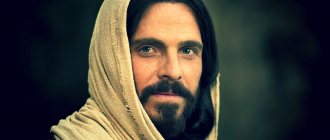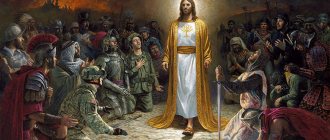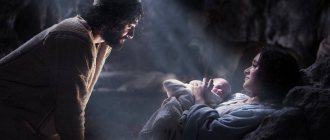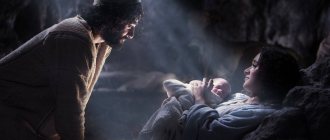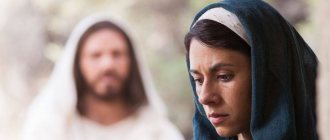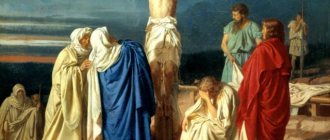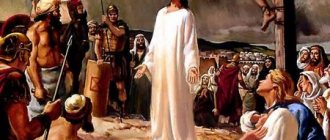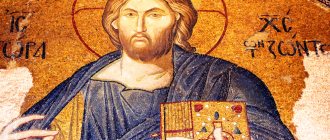| Icons of the Savior |
|
Great Hierarch
is a symbolic designation of Jesus Christ, based on the Old Testament prophecy (
“You are a priest forever in the order of Melchizedek”
(Ps. 109:4)), commented on by the Apostle Paul (
“called by God High Priest in the order of Melchizedek”
(Heb. 5:10) ).
Also mentioned in Zechariah: “And he showed me Jesus the great priest standing before the angel of the Lord, and Satan standing at his right hand to oppose him”
(Zech. 3:1).
In art
In icon painting, the Great Bishop is an image of Christ in a bishop’s robe, which is found both independently and in combination with other symbolic images. Thus, there is a stable iconography of the King by the King - the Great Bishop, combining the royal and priestly titles of Christ (derived from the words of the Apostle Paul - “first, by sign [name] the king of righteousness, and then the king of Salem, that is, the king of peace"
(Heb. 7:2)).
In the Kiev Cathedral of Hagia Sophia, in the apse above the Mountain Place there is a mosaic image of Christ the Priest in a round medallion. Christ is depicted as an almost beardless young man, with a haircut on His head. The fresco “Christ the Priest” was part of the cycle of paintings of the Church of the Savior on Nereditsa (in the niche under the lower window of the altar apse). Images of Christ the Priest cannot be traced later than the 13th century, then they are replaced by the iconographic type of the Savior the Great Bishop. The placement of the images in the altar apse indicates the direction of the images to the clergy. Obviously, one of the functions of the image is to serve as a reminder that the priest during the liturgy symbolizes (is a living icon) Christ.
- Ushakov Great Archierey.jpg
Great Bishop. Simon Ushakov.
- Spas Arhierey Velikiy.jpg
Savior Bishop the Great. Late 17th century
- Inside dome of Dormition Church at Kondopoga.jpg
"Heavenly Liturgy". Painted sky of the Church of the Assumption of the Virgin Mary in Kondopoga (1774). Central medallion - Savior the Great Bishop
"THE GREAT HISH JESUS CHRIST"
Iconographic type representing Christ in bishop's vestments; became widespread in the late and post-Byzantine periods. art. It is one of the variants of the image of Christ the High Priest, which is based on the text: “The Lord has sworn and will not repent: You are a priest forever according to the order of Melchizedek” (Ps 109.4) and its interpretation in the Epistle to the Hebrews (4.14; 5. 5-10). Found as separate images of “V. A.”, as well as in the compositions “Eucharist” and “Heavenly Liturgy”, common in the late Byzantine period. art. The themes of the hierarchical ministry of Christ, the unity of heavenly and earthly liturgy are emphasized in the scene “Communion of the Apostles” in the painting on the wall of the central apse in the churches: St. Nikita, near Skopje (Macedonia), approx. 1320; St. Nicholas Orphanos in Thessalonica, 2nd quarter. XIV century; Christ Pantocrator of the Decani Monastery (Serbia, Kosovo and Metohija), 1335-1350. (the scene is placed in the apse concha); Our Lady of Matejce Monastery, near Skopje (Macedonia), 1356-1360; St. George in Poloshko (Macedonia), ca. 1370 - V. A. is represented everywhere in the sakkos, without an omophorion, giving communion to the apostles.
"Like the Cherubs". Icon. 1570 (Tretyakov Gallery) “Like the Cherubs”. Icon. 1570 (Tretyakov Gallery)
In c. Ascension Monastery of Ravanica (Serbia), ca. 1387, V. A. is depicted in the altar in the composition “Eucharist” in front of the throne, blessing the apostles with both hands, dressed in a sakkos and omophorion, and in the dome in the composition “Heavenly Liturgy” - with a censer in his hands, meeting the procession of angels with the Gifts. He is also represented in the composition “Heavenly Liturgy” on the panagiar, 2nd floor. XIV century from the Xiropotamus monastery, in the apse c. Vmch. Demetrius Markov monastery (Macedonia), 1376-1381, in the painting of the domes of a number of Athos cathedrals, for example. Dochiar monastery, 1568
In the scene “Adoration of the Sacrifice” in the altar c. monastery in Modrishte (Macedonia), 80s. XIV century, V. A. is depicted with the Gospel in his hands; on an embroidered catapetasma from Hilandar, performed by mon. Euphemia in 1398/99 - blessing with both hands, with the upcoming saints Basil the Great and John Chrysostom. In the painting c. arch. Michael in Lesnov (Macedonia), 1346, in the domed composition “Heavenly Liturgy” the image of V.A. is absent, but is presented twice in the altar: in the lower tier of the central apse under the scene of “Communion of the Apostles” and in the niche of the deacon. In the apse, Christ, surrounded by a double radiance of glory, in the outer ring there are 2 seraphim with ripids, blesses with both hands the Holy Gifts standing on the throne. Between the chalice and the paten lies an unfolded scroll with the initial words of the liturgy: “Blessed is the kingdom of the Father and the Son...”; Christ is depicted in the baptized sakkos and omophorion, with his head uncovered. On the sides are 2 angels in deacon's surplices with their hands covered in red scarves. In the deaconium, Christ is presented full-length, also with his head uncovered, with his right hand blessing with two fingers, and in his left - a closed Gospel. He is wearing an ornamented sakkos, omophorion and stole with half-figures of the 12 apostles in medallions in the form of vine curls. The 2 lower medallions depict the prophets Samuel and David.
In the altar c. Our Lady of Periveleptos in Mystras (Greece), 3rd quarter. XIV century, V.A. is represented standing behind the throne under the ciborium, surrounded by concelebrating angels, his left hand on the throne, his right hand blessing; above the ciborium in the medallion is the Holy Spirit in the form of a dove, above is Christ
“Tsar by Tsar” (Great Bishop). Icon. Con. XVI century (GRM)
“Tsar by Tsar” (Great Bishop). Icon. Con. XVI century (GRM) Old Denmi in a blaze of glory and on the sides there are 2 cherubs. Also behind the throne is depicted V. A. performing the liturgy in the apses of the cathedrals of Gelati (Georgia), XIV century, and Iveron Mon-Rei on Mount Athos. In these scenes, His clothing and gestures, as a rule, correspond to the rite of bishop's worship. For example, in the painting c. St. Nicholas the Great Lavra on Mount Athos, 1560, V.A. is presented in a three-quarter turn, blessing with both hands 2 angels in deacon's robes bowing to Him, with censers and candles in their hands. The theme of heavenly liturgy was developed in Russian. art in the XVI-XVII centuries. (for example, the icons “Like the Cherubim” from Solvychegodsk, 1579 and the 17th century (Tretyakov Gallery); the icon “Now the heavenly powers serve with us invisibly,” 1st half of the 17th century (Tretyakov Gallery)).
Iconography "V. A." is close to another iconographic type of Christ, based on the texts of the 109th and 44th psalms - “King by King”, which took shape in the 14th century. and is presented primarily in the compositions “The Queen appears at Your right hand,” where Christ is depicted in the royal sakkos, with a lor and omophorion, in a crown-kamilavka, often accompanied by the inscription: “You are a priest according to the order of Melchizedek” (painting by the Church of the Savior on Kovalev, 1380 - see Ostashenko. P. 184; icon, 1562 (State Russian Museum), and sometimes the inscription: “Bishop the Great" (icon of Nikita Pavlovets, 1676 (Tretyakov Gallery)). Under the influence of this iconography on Russian icons and in paintings on the theme of Heavenly Liturgy, images of V.A. in a mitre appear (for example, the painting of the paracleis of St. John the Baptist of the Iveron Monastery).
Lit.: Ainalov D. New iconography. image of Christ // SK. 1928. T. 2. P. 19-24; Jovanovic P. Modrichki manastir // GSND. 1928. [Књ.] 3. P. 279; Ostashenko E. Ya. About the iconography of the type of icon “Present Queen” of the Assumption Cathedral of the Moscow Kremlin // DRI. M., 1977. S. 175-187; Stefanescu ID L'Illustration des Liturgies dans l'art de Byzance et de l'Orient. Brux., 1936; Walter C. Art and Ritual of the Byzantine Church. L., 1982. P. 216-217; Παπαμαστοράκις Τ. Η μορφη+ τοῦ Ξριστοῦ-Μεγάλου ´Αρχιερέα // ΔΞΑΕ. 1993/1994. Τ. 17. Περ. 4.
N. V. Kvlividze
Excerpt characterizing the Great Bishop
The Emperor called the regimental commander and said a few words to him. "My God! what would happen to me if the sovereign addressed me! - Rostov thought: “I would die of happiness.” The Emperor also addressed the officers: “Gentlemen, every word was heard by Rostov like a sound from heaven,” I thank you with all my heart. How happy Rostov would be if he could now die for his Tsar! – You have earned the banners of St. George and you will deserve them. “Just die, die for him!” thought Rostov. The Emperor also said something that Rostov did not hear, and the soldiers, pushing their breasts, shouted: Hurra! Rostov also screamed, bending down to the saddle as much as he could, wanting to hurt himself with this cry, only to fully express his admiration for the sovereign. The Emperor stood for several seconds against the hussars, as if he was undecided. “How could the sovereign be indecisive?” thought Rostov, and then even this indecision seemed to Rostov majestic and charming, like everything that the sovereign did. The sovereign's indecisiveness lasted for an instant. The sovereign's foot, with a narrow, sharp toe of a boot, as was worn at that time, touched the groin of the anglicized bay mare on which he was riding; the sovereign's hand in a white glove picked up the reins, he set off, accompanied by a randomly swaying sea of adjutants. He rode further and further, stopping at other regiments, and, finally, only his white plume was visible to Rostov from behind the retinue surrounding the emperors. Among the gentlemen of the retinue, Rostov noticed Bolkonsky, sitting lazily and dissolutely on a horse. Rostov remembered his yesterday's quarrel with him and the question presented itself whether he should or should not be summoned. “Of course, it shouldn’t,” Rostov now thought... “And is it worth thinking and talking about this at a moment like now? In a moment of such a feeling of love, delight and selflessness, what do all our quarrels and insults mean!? I love everyone, I forgive everyone now,” thought Rostov. When the sovereign had visited almost all the regiments, the troops began to pass by him in a ceremonial march, and Rostov rode in the Bedouin newly purchased from Denisov in the castle of his squadron, that is, alone and completely in sight of the sovereign. Before reaching the sovereign, Rostov, an excellent rider, spurred his Bedouin twice and brought him happily to that frantic trot gait with which the heated Bedouin walked. Bending his foaming muzzle to his chest, separating his tail and as if flying in the air and not touching the ground, gracefully and high throwing up and changing his legs, the Bedouin, who also felt the sovereign’s gaze on him, walked excellently.
The icon of the Savior, the Great Bishop, is very suitable for reading the Apostle of today.
The content of the icon “Savior the Great Bishop” receives its explanation from the Epistle of the Apostle Paul to the Hebrews. The idea of the Divine High Priesthood of Jesus Christ is a central motif in several chapters of the Epistle (Heb. 3-10). The ministry of Christ according to the order of the Heavenly Bishop stems from the general plan of the economy of the Son of God and corresponds to the very image of the saving actions of Jesus Christ. Just like a priest, He brings an atoning sacrifice to God the Father for the sins of mankind, but He Himself is the only sacrifice: “Thou art the Offerer and the One who is Offered,” says the priestly prayer of the Cherubic Song. Interceding before God for all people, Christ acts on their behalf as the High Priest. Moreover, He did not assign to Himself the glory of being a High Priest, but He who said to Him: “You are My Son, today I have begotten You” (Heb. 5:5). The greatness of the high priestly ministry of Jesus Christ, due to the peculiarities of its fulfillment and results, obliges us to see in Christ not an ordinary bishop, like the main high priests of the Old Testament: “... those priests were many, because death did not allow one to remain alone, but He, as one who abides forever, He also has an enduring priesthood, and therefore can always save those who come to God through Him, being always alive to intercede for them. This is how our High Priest should be; holy, free from evil, blameless, separated from sinners and exalted above the heavens, who does not need daily, like those high priests, to offer sacrifices first for his own sins, then for the sins of the people, for He did this once, sacrificing Himself. For the law appoints as high priests those who have infirmities; and the word of oath, after the law, established the Son, perfect forever” (Heb. 7: 23-28). “Christ did not enter into a sanctuary made with hands, built in the image of the true one, but into heaven itself, now to appear for us before the face of God, and not in order to offer Himself many times, as the high priest enters the sanctuary every year with the blood of others; otherwise He would have had to suffer many times since the beginning of the world; He once, towards the end of the centuries, appeared to destroy sin through His sacrifice. And just as it is appointed for men to die once, and then judgment, so Christ, having once offered Himself as a sacrifice to take away the sins of many, will appear a second time, not for the atonement of sin, but for the salvation of those who wait for Him” (Heb. 9:24-28 ). In accordance with the teaching of the Apostle Paul about the priesthood of Christ, He is glorified by the Church as the Great Bishop, the High Priest of the new confession, “who is seated at the right hand of the throne of the Majesty in heaven, and is a minister of the sanctuary and of the true tabernacle, which the Lord pitched, and not man” (Heb. 8, 1-2). Another feature of the priesthood of the Lord Jesus Christ is the mysterious combination by Him in His Person of two titles at once - He is a Priest and a King at the same time. The Lord God announced about Him through the psalmist David: “Thou art a priest forever, according to the order of Melchizedek” (Ps. 109:4). King and priest, as was customary in pre-legal times, the Old Testament Melchizedek was a prototype of Christ and His sacred kingdom. Such a merging of two aspects of dominion - spiritual and civil, apparently gave reason for the icon of the “Savior of the Great Bishop” to also be called the “King of Kings”.
Source: I. A. Pripachkin. ICONOGRAPHY OF THE LORD JESUS
Achilles
Views: 2,799
I will share some thoughts that were prompted by a note on the telegram channel “Orthodoxy and Zombies” regarding the comment of the respected Archpriest Leonid Kalinin about the black Christ on the fresco . With Kalinin, in principle, it is clear: “whose cow would moo”; let the god of war pray and remain silent on your golden idol in the temple. And what aroused annoyance in the article was the “vanilla”, unctuousness in several (beautiful in theory, smooth on paper) judgments. I will take only a few fragments from the article itself.
I
“The Japanese portray Christ as a Japanese, the American Indians as an Indian, the Aleuts as an Aleut, the inhabitants of black Africa as a black man. Those in power portray Christ as a king...” The list can be continued as much as you like, the question is what is behind this, what motivates it: “This is how people express their hope that the God-man has come specifically to them, here, here and now.” Well, well, it sounds beautiful, no doubt about it. Only if you descend slightly to the sinful earth, then with the naked eye you can see that in fact, in many cases, what drives the choice of depiction method is the desire of a certain person or group of people to see Christ “convenient” for themselves, similar to themselves. A huge number of interest groups want to win him over to their side: the communists want to see him as a communist, the patriots as a patriot, the imperials as an imperial, the philatelists as a philatelist...
How exactly to portray it is just the tip of the iceberg, but it’s already the beginning of a lie when they want to adapt it to the audience. It is not to take the audience out of their comfort zone and elevate it to his sermon (for the crowd, the herd, to put it mildly, will not like everything), but to adapt it, to smooth out the sharp edges. “This word is cruel and who can listen to it.” Christ is provocative (“Not a priest, not a political revolutionary, not an ascetic monk, not a pious moralist, he is provocative in all directions.” Hans Küng, “The Christian Challenge”), does not say what many want to hear, and then they begin to subconsciously try to attract to your side, including through a visual image. And a small lie opens the door to a big lie.
I’m not bothering at all with advice - but then how, “in my opinion,” should he be portrayed: undoubtedly, even without Negroids, bishops and mechanical Pantocrators with withering glances, and other deliberate manipulations, there remains a huge creative space. And I’m not talking about the subtleties of iconography; I just started the conversation with images. I'm talking about the conscious manipulation of the consciousness of believers (and not only) with the help of a visual image.
As a striking example, I will cite icons where Christ is depicted in full vestments of a bishop; such icons can now often be found in Orthodox churches. I cannot judge to what extent this image, called “Christ the Great Bishop,” is currently in trend; as I understand it, most of the available icons of this type are rather a legacy of the Synodal era. But we are now trying to grasp the message that such an image carries.
Often on these images the elements of vestments and all the crosses and patterns on them, sparkles on the miter, and all other jewelry are drawn in great detail. It is clear that, according to the idea, the viewer has an associative series - the bishop looks like Christ from the icon (and vice versa), they are even dressed the same. The Great Bishop whispers from the icon: “I sent you bishops and priests, I gave them a franchise, these are My people, and you, worms, listen to them and humble yourself.” How relevant it could be. While the image of the modern bishop in the minds of many people (and every day more and more comes to this conclusion) personifies the insatiable Mammon, the spineless seller of Christ, who, without hesitation, renders God's tribute to Caesar, without even blushing - in the churches the Great Bishops, their allies , tirelessly preach the opposite with their very appearance.
II
“For the salvation of people, it is not the nationality or even the gender of Christ that is important...” (From this moment I will completely move away from the above text to more general reflections, which are something like “confession of a churchgoer .”)
As soon as I hear Orthodox Christians start scribbling something about salvation, I instantly have an allergic reaction to it. I've seen enough of how they are saved. Thank you, just do as you wish, but I don’t need such “salvation” as yours for nothing...
However, if a person basically doesn’t understand what I’m talking about now, then there’s no point in trying to explain. Such thoughts and views are born from experience, having been suffered over time, and not gleaned from books or simply verbally transmitted from one person to another. Here are years of careful nurturing of critical thinking in spite of hammered-in dogmas and attitudes.
That religiosity, that “spiritual life” (it’s generally disgusting to talk about the abominations of church realities) that I observed among those “being saved” was so filled with falsehood, self-deception, intertwined with everything from which I prefer, as far as possible, to be saved. I’d rather save myself from illusions, naivety, captivity of colorless dreams, rose-colored glasses, pretense, hypocrisy, compromises with conscience, groveling, servility, servility, role-playing games, attitudes, polar thinking, indoctrination and other things that are contrary to common sense and human dignity and is disgusting.
III
Once, in one conversation, he spoke with indignation about a blatant, but quite typical case, which became widespread on the Internet thanks to a video shot: in N-sk, in the stains of urine on the wall, people recognized the “face” as an honest one, and crowds began to flock to this image people, pray and kiss the miraculous image not made by hands; The priests also joined in with prayers, candles and notes. There was no need for artists or sculptors here, except, perhaps, for local lovers of relieving themselves on the wall around the corner. A real triumph of the absurd, senseless and merciless. So, my interlocutor objected that, they say, people strive for the light, well, at least in the best way they can, and I just criticize everything.
So it suggests itself: if the light that is in you is darkness... If the desire to indulge your illusions, the desire to kiss the urinary “face” on a pissing wall, overwhelmed by the lust of wishful thinking, is a desire for light, then so be it - on definitely the dark side. But only in your understanding. For me, the desire for light is manifested in the desire to call a spade a spade, not in escaping from reality into the comfortable cool darkness, the sweet captivity of illusions, but in leaving precisely the darkness of ignorance. From whom you don’t even want to hear about the divine, about the transcendent, are those who don’t want, before talking about the “high,” to accept themselves and this world, to first try to accept this reality as it is, to get to the bottom of the truth , which, to great disappointment, can greatly hurt your eyes, because it can completely contradict what you thought; what you spent years and energy on.
Blessed are those who hunger and thirst for truth... And this very truth can, to our displeasure, lead us out of a comfortable stay in illusions, such as Christ, who belongs to the board and is undoubtedly “with us”, on our side, or that the priests understand him correctly and they can broadcast on his behalf, because they have a franchise and a monopoly on the truth, or that in these stains on the wall - it’s him, look - it’s definitely him!
If you like our work, support us:
Sberbank card : 4276 1600 2495 4340 (Pluzhnikov Alexey Yurievich)
Or using this form, entering any amount:
